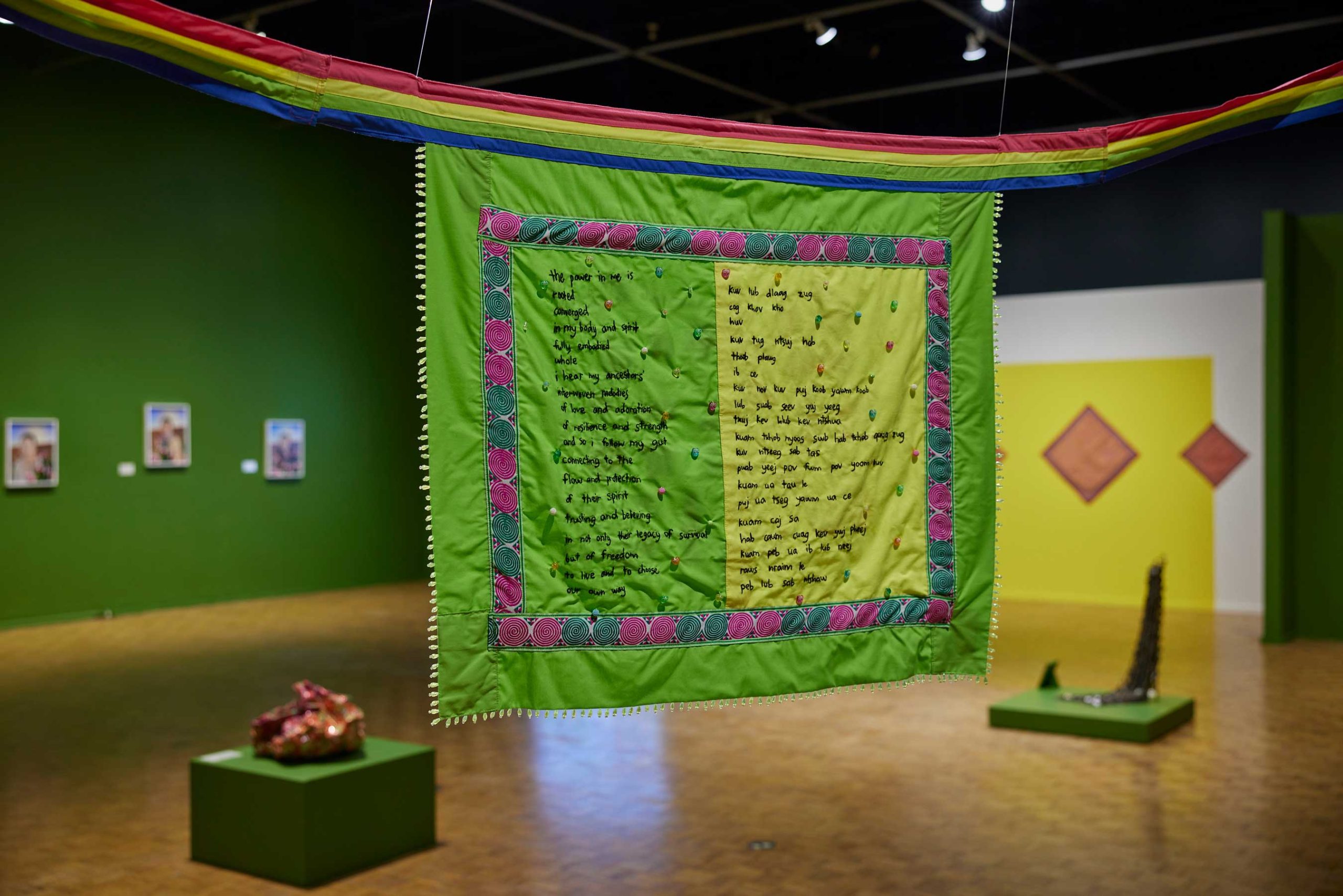Two-Day Symposium Focuses On HMong Art Practices and Issues, April 6 – 7 At John Michael Kohler Arts Center In Sheboygan
By Patricia DuChene
The Cloth as Land exhibition at the John Michael Kohler Arts Center in Sheboygan makes the remarkable claim that HMong Indigeneity exists within their textiles. A free two-day symposium on April 6 and 7 at the Arts Center offers a deeper, more intimate look into the questions and conversations behind the development of that show.
The symposium will bring together HMong artists, artisans, leaders, and community members to engage with a variety of HMong art practices. From traditional craft to contemporary art, the conversations will explore issues around commercialization, collecting, and conservation. Hands-on workshops and activities will nurture a deeper understanding of a living repertoire of art made through people’s hands.
The artworks on view in the exhibition illustrate abstract forms of landscapes, identities, nations, and places that dispute claims against belonging to consider Indigenous kinship. As textile metaphors remain visible within the practices of HMong artists today, they are also an enduring symbol of the reclamation and revitalization that persists in a new era of HMong imagining.
The Cloth as Land Symposium unravels the threads of the exhibition and centers HMong artists and curators alongside organizations and institutions in panel discussions and hands-on workshops that explore the past, present, and future of HMong arts.
Visit jmkac.org or call (920) 458-6144 for a schedule of events and to register for one or both days of the Cloth as Land Symposium. Registration is free. Workshop seating is limited. The Cloth as Land exhibition is on view at the John Michael Kohler Arts Center through June 16; admission is free.
The Arts Center is located at 608 New York Ave., Sheboygan, WI. Free parking is available in the Arts Center lot on New York Avenue.
Here is some of what participants can experience during the symposium.
Artist Panel: Cloth Conversations
The artists featured in the exhibitions Cloth as Land: HMong Indigeneity and Cloth Origins: Textiles from the HMong Journey will talk about their artistic practices, looking at how they continue ancestral cloth practices to express cultural identities, negotiate assimilation, heal from trauma, uncover personal narratives, and make art in community.
Collecting & Caring for Hmong Arts
This panel of experts and practitioners from museum studies, HMong studies, and the arts will discuss the support, collection, and care of HMong art, artifacts, and stories. They will explore the complexities and challenges of preserving and presenting HMong arts and culture in museum settings.
Coins of Positivity
Inspired by the art in Cloth as Land: HMong Indigeneity exhibition, participants to talk about feelings by creating coins of positivity through illustration and writing that will be added to a collective wall of HMong embroidery patterns.
Conceptualizing Land
Land continues to be a central concept for HMong people when thinking about home, place, and belonging. Participants will explore and share their understanding and theories about “land.” This workshop will utilize performance art to talk about, imagine, and depict HMong ideas of the word “land.”
Curators’ Talk
The curators of Cloth as Land: HMong Indigeneity and the Cloth Origins: Textiles from the HMong Journey exhibitions at the Arts Center and the Mao Lor: A Journey through Hmoob Paj Ntaub exhibition at the Paine Art Center and Gardens will discuss their curatorial practices. Among the topics will be what it means for HMong women to curate HMong exhibitions that disrupt ways HMong people have been exoticized in the past.
Coded Kinship
This presentation features a video screening and panel discussion of coded meanings in HMong art as a way to preserve oral traditions such as poetry, storytelling, and more. The intergenerational panelists will share their reactions to the screening of the short film Spicy Legacy Project. The panel will discuss the importance of oral traditions like kwv txhiaj poetry chanting, nkauj Hmoob HMong songs, and qhia dab neeg storytelling in preservation of HMong cultural identity.
Applying and Cutting Flower Cloth: HMong Appliqué
Xao Yang Lee is an acclaimed paj ntaub (flower cloth) artist whose textiles were recently featured in Cloth Origins: Textiles from the HMong Journey at the John Michael Kohler Arts Center. Participants will create appliqué pieces with HMong symbols and motifs connected to nature and land. Appliqué will be taught on Saturday with reverse-appliqué taught on Sunday.
Practice Rhythms of HMong Oral Traditions
This workshop, led by hip-hop artist Tou SaiKo Lee with guest elder Neng Vang “Tais Neeb,” will engage us in the creative process of kwv txhiaj, poetry chanting, paj huam poetry, HMong language hip-hop, and intergenerational collaborations.
Cloth as Land: Hmong Indigeneity is funded by grants from the Henry Luce Foundation, the National Endowment for the Arts, the Terra Foundation for American Art, Travel Wisconsin, and Wisconsin Humanities, with funds from the National Endowment for the Humanities.
About the John Michael Kohler Arts Center
Founded in 1967, the John Michael Kohler Arts Center (JMKAC) is dedicated to generating creative exchanges between an international community of artists and a diverse public. Central to its mission is promoting understanding and appreciation of the work of self-taught and contemporary artists through original exhibitions, commissioned works of art, performing arts, community arts initiatives, and publications.
The Arts Center’s collection focuses primarily on works by artist-environment builders, self-taught and folk artists, and works created in the Arts/Industry residency program. JMKAC is the world’s leading center for research and presentation of artist-built environments.
In June 2020, the Arts Center opened the Art Preserve, a satellite campus highlighting its collection of 25,000 individual works of art by more than 30 art-environment builders. The Art Preserve features immersive displays of art environments and curated visible storage of environment components. It also serves as a resource for research on art environments and the artists who create them.
The John Michael Kohler Arts Center is located at 608 New York Avenue, Sheboygan, WI. The Art Preserve is located at 3636 Lower Falls Road, Sheboygan. Admission to both is free. For more information, call 920-458-6144, or visit jmkac.org, Facebook, Twitter, or Instagram.
The John Michael Kohler Arts Center is supported by corporate and foundation donors, government grants, and its many members. The Arts Center is not an entity of Kohler Co. or its subsidiaries.
Hours
Tuesday, Wednesday, Friday: 10:00 a.m. – 5:00 p.m.
Thursday: 10:00 a.m. – 8:00 p.m.
Saturday, Sunday: 10:00 a.m. – 4:00 p.m.
Location
John Michael Kohler Arts Center: 608 New York Avenue, Sheboygan, WI
Art Preserve: 3636 Lower Falls Road, Sheboygan, WI
Images courtesy John Michael Kohler Arts Center.












